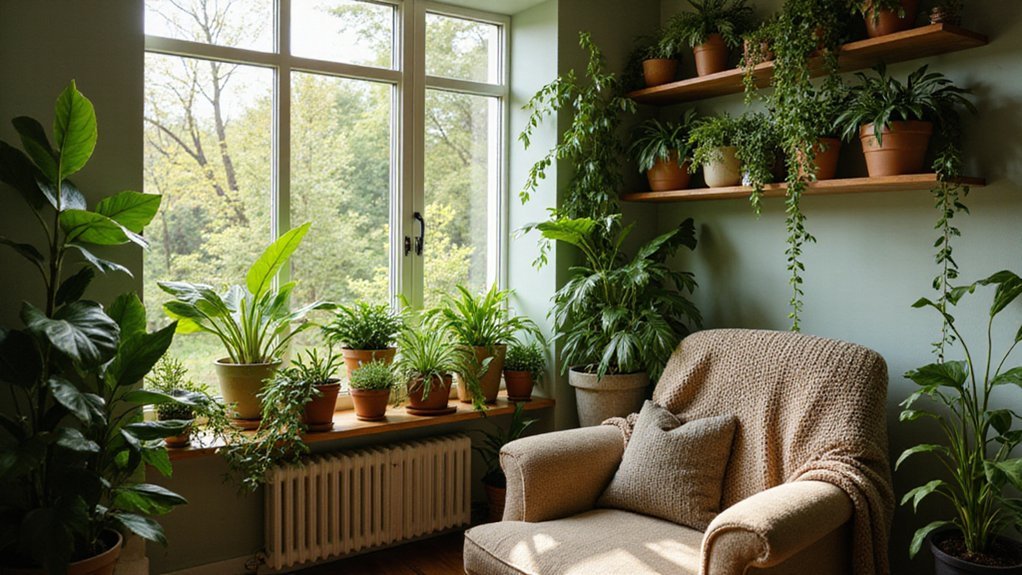Research shows that 85% of urban dwellers experience chronic stress, making nature connection more critical than ever. You’re likely seeking sanctuary from overwhelming daily pressures, and forest bathing at home might be your unexpected solution. Indoor plants and mindful practices can transform your living space into a healing environment. By reimagining your home as a personal wellness ecosystem, you’ll discover how nature’s therapeutic power can restore balance and calm. Curious about how simple green interventions can revolutionize your well-being?
Key Takeaways
- Create an indoor nature sanctuary with low-maintenance plants like snake plants and peace lilies to filter toxins and reduce stress levels.
- Engage multiple senses through intentional plant interactions, including touching bark textures, diffusing forest-inspired essential oils, and listening to nature sounds.
- Develop daily mindfulness rituals around plant care, transforming maintenance tasks into meditative practices that promote emotional balance and inner calm.
- Document your plant-based wellness journey in a nature journal, tracking emotional shifts, plant growth, and personal recovery progress systematically.
- Utilize phytoncides and natural aromatherapy from plants like lavender and eucalyptus to enhance immune function and decrease anxiety by up to 37%.
Understanding Forest Bathing Principles

Although forest bathing might seem like a novel wellness trend, its roots run deep in Japanese cultural practices and scientific research. You’ll discover that this practice isn’t just about walking in woods, but intentionally immersing yourself in a forest atmosphere that actively engages all your senses. By mindfully experiencing nature’s subtle elements, you can reduce stress and access significant health benefits.
The core principle involves sensory connection: listening to rustling leaves, touching tree bark, breathing in phytoncides released by trees. These natural interactions trigger physiological responses that lower cortisol levels and enhance immune function. Whether you’re in an actual forest or creating a nature-inspired space at home, the goal remains consistent – cultivating a profound, healing connection with the natural environment that supports holistic well-being.
Creating Your Indoor Nature Sanctuary
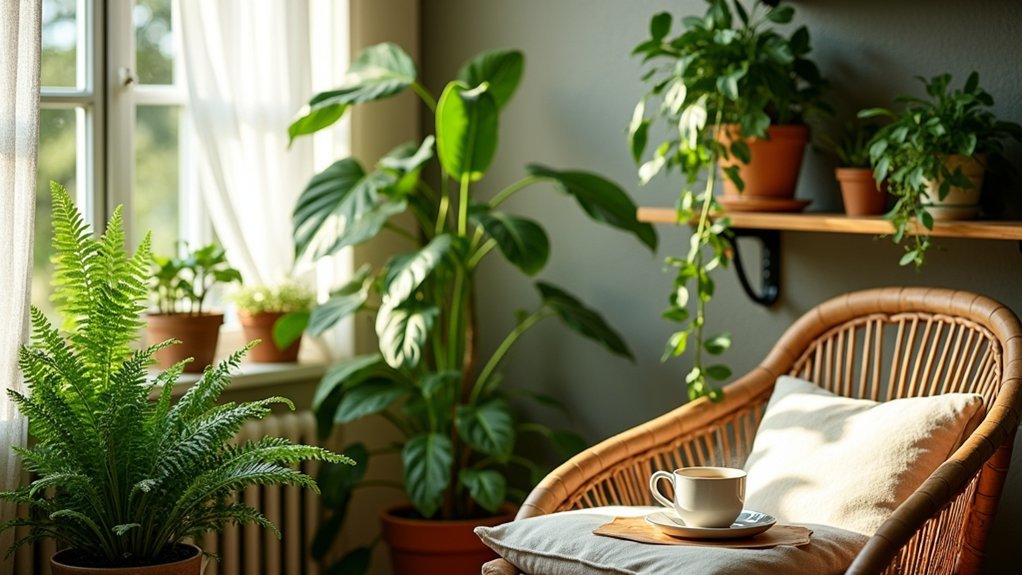
Since urban living often disconnects us from nature’s healing embrace, you can transform your indoor space into a rejuvenating forest sanctuary that nurtures mental and physical well-being. Strategically incorporate natural elements like wood furniture, stone accents, and carefully selected houseplants to mimic a forest’s calming atmosphere. Low-maintenance plants such as snake plants not only enhance aesthetic appeal but also improve indoor air quality and reduce stress.
Harness the power of essential oil diffusers with cedarwood or pine fragrances to evoke woodland sensations. Position plants near windows to maximize natural light, or use sunlight simulation lamps that boost mood. Small indoor fountains can provide soothing water sounds, completing your sensory forest experience and creating a therapeutic environment that reconnects you with nature’s restorative energy.
Essential Indoor Plants for Wellness
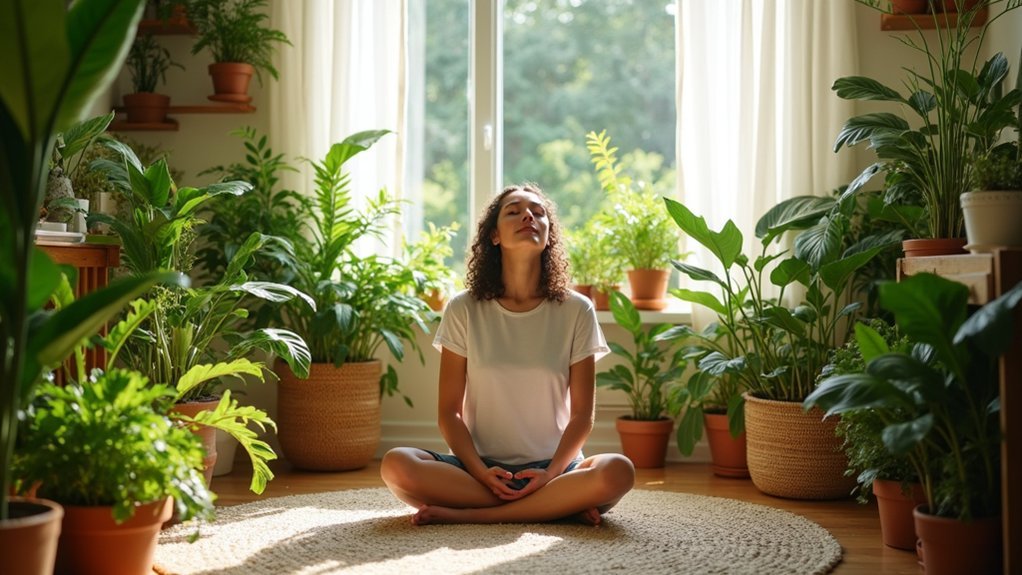
As you curate your indoor wellness sanctuary, selecting the right plants becomes a transformative strategy for enhancing mental and physical health. Indoor plants like snake plants and peace lilies aren’t just decorative; they’re powerful wellness tools that filter toxins and reduce stress hormone levels. Spider plants and pothos offer low-maintenance green solutions that thrive in diverse environments, helping you create a restorative space.
Research reveals these botanical companions can decrease anxiety by up to 37% and boost productivity by 15%. Aromatic options like lavender and eucalyptus provide an additional sensory dimension, releasing calming scents that promote relaxation. By strategically incorporating these plants, you’ll transform your living space into a natural healing environment that supports holistic well-being and mental restoration.
Sensory Engagement Techniques
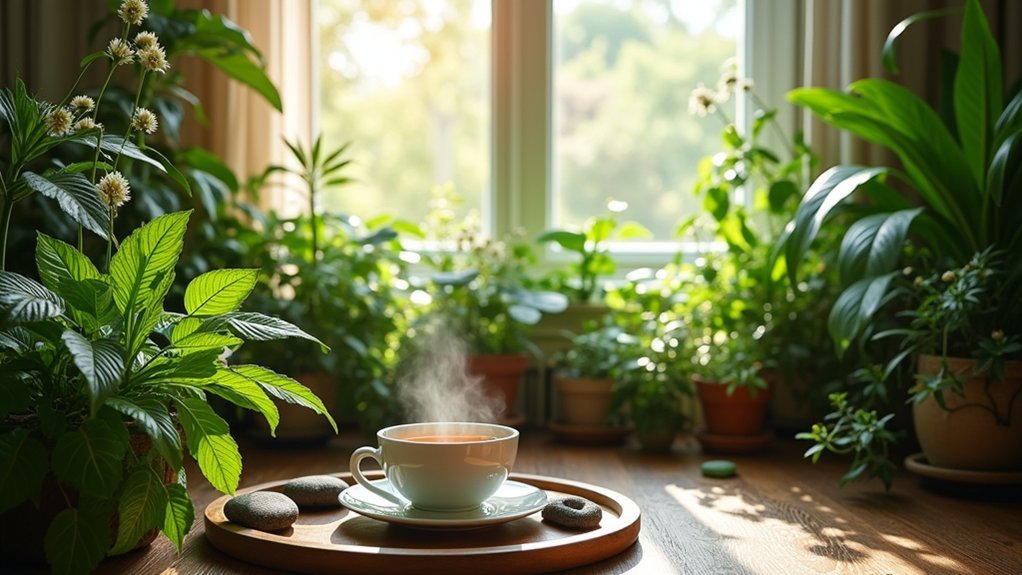
The art of sensory engagement transforms indoor forest bathing from a passive experience into an active journey of wellness and self-discovery. By deliberately focusing on individual senses, you’ll activate your nervous system and enhance mental health through intentional interaction with nature.
| Sense | Technique | Benefit |
|---|---|---|
| Touch | Plant textures | Tactile connection |
| Sound | Nature audio | Stress reduction |
| Smell | Essential oils | Relaxation |
| Sight | Leaf observation | Mindful awareness |
Deep breathing while exploring natural elements creates a powerful sensory experience. Collect leaves, stones, or twigs to stimulate tactile awareness. Listen to subtle sounds, inhale natural fragrances, and visually examine plant details. Each sensory interaction becomes a mindful moment, helping you reconnect with nature’s healing rhythms and cultivate inner calm through deliberate, focused engagement.
Breathing and Meditation Practices
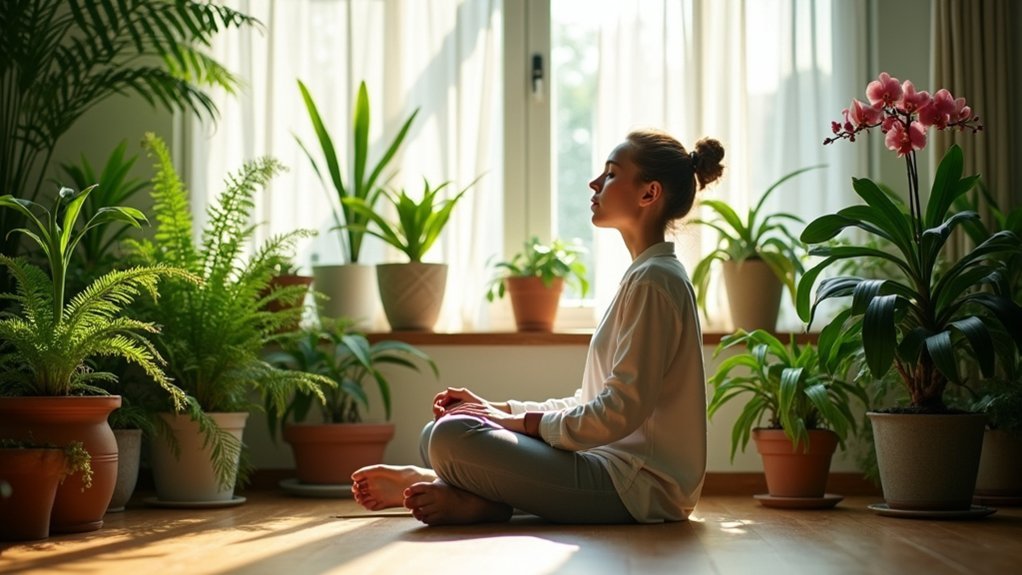
Breathing and meditation practices form the cornerstone of an effective indoor forest bathing experience, transforming your personal space into a sanctuary of tranquility. By employing deep belly breathing techniques, you’ll activate your parasympathetic nervous system, reducing stress and enhancing emotional well-being. Focus on extending both your inhale and exhale while visualizing serene forest landscapes, creating a powerful connection with the natural environment.
Nature-inspired meditation can amplify your indoor forest bathing practice. Visualize lush green surroundings, letting your breath guide you into a mindful state. These intentional breathing and meditation practices not only improve cognitive function but also foster a profound sense of calm. Through consistent practice, you’ll develop a deeper understanding of how meditation and breathwork can transport you to a peaceful, restorative forest-like setting.
Designing Your Personal Forest Room
While forest bathing traditionally occurs outdoors, you can transform an indoor space into a rejuvenating forest sanctuary that nurtures your well-being. Design your personal Forest Room using natural world elements like wood, stone, and abundant indoor plants to create a biophilic environment that mimics woodland settings. Strategically place greenery to improve air quality and foster a connection with nature. Incorporate soft water features and gentle lighting to simulate forest atmospheres, using essential oils to enhance sensory experiences. Thoughtfully arrange natural materials and textures that invite relaxation and mindful forest bathe practices. Select plants that thrive indoors and create layers of green spaces that promote healing and tranquility. Your carefully curated indoor forest can become a powerful refuge for mental and physical restoration.
Natural Aromatherapy Strategies
Just as forests teem with complex, interconnected life, natural aromatherapy offers a powerful pathway to wellness through carefully selected essential oils. You can harness the therapeutic potential of tree-based fragrances to create a healing environment:
- Select cedar wood and pine essential oils to simulate the smell of the forest, which can activate your natural killer cells and reduce stress.
- Use portable diffusers and roller balls to access calming aromas throughout your day, bringing the woodland experience wherever you go.
- Integrate essential oil practices into your daily routine, strategically placing diffusers to stimulate your limbic system and promote emotional balance.
Sound and Light Healing Methods
As aromatherapy awakens our sensory connection to nature, sound and light healing methods offer another profound pathway to recreate forest bathing experiences at home. By strategically integrating sound therapy through nature sound apps and high-quality recordings, you’ll mimic the calming environments of forests and waterfalls. Natural light exposure plays an essential role, regulating your circadian rhythms and enhancing mood while complementing essential oils’ therapeutic effects.
Maximize your indoor forest bathing by streaming ambient forest soundscapes and positioning yourself near natural light sources. The combination of soothing audio and gentle sunlight can greatly reduce stress, promote relaxation, and create a mindful atmosphere that echoes the restorative qualities of woodland environments. These holistic techniques transform your living space into a sanctuary of healing and tranquility.
Daily Rituals for Nature Connection
Creating daily rituals that nurture your connection to nature transforms indoor living spaces into sanctuaries of wellness and mindfulness. Your plant-based recovery journey can unfold through intentional practices that ground you in the natural world:
- Cultivate a morning plant care routine, mindfully watering and tending to indoor greenery, turning routine maintenance into a meditative experience.
- Design a sensory environment using essential oils like cedarwood or pine, which evoke forest atmospheres and promote relaxation through aromatherapy.
- Establish a nature journal, documenting daily observations and reflections about your indoor plants, light patterns, and subtle environmental shifts.
Tracking Your Plant-Based Recovery Journey
Tracking your plant-based recovery journey transforms personal wellness into a tangible, measurable experience through intentional documentation and reflection. By maintaining a nature connection journal, you’ll capture the subtle shifts in your emotional and physical landscape, much like the gradual healing observed in Forest Therapy practices.
Digital tools and apps can help you log meals, track immune system improvements, and monitor your energy levels. Set specific goals around plant-based nutrition, such as introducing new herbs or increasing vegetable intake. Regularly documenting the benefits of forest-inspired dietary choices allows you to observe your holistic recovery process.
Engaging with online plant-based communities provides additional accountability and support. Your journal becomes a roadmap of transformation, revealing how intentional nutrition and nature connection can profoundly impact your wellness journey.
Frequently Asked Questions
How to Forest Bathe at Home?
You’ll immerse yourself in nature through sensory engagement activities: diffuse woodsy oils, surround yourself with indoor plants, play forest sounds, and practice mindful breathing to experience the healing benefits of indoor nature immersion techniques.
Is Forest Bathing the Same as Grounding?
No, they’re different. While grounding focuses on direct earth contact for physiological benefits, forest bathing immerses you in sensory nature experiences. Both offer unique nature connection, but forest bathing provides deeper, holistic sensory immersion beyond grounding’s physical benefits.
What Is the Difference Between Shinrin-Yoku and Forest Bathing?
You’ll find shinrin-yoku is a specific Japanese practice of nature immersion, while forest bathing is a broader concept. Both share forest bathing history and health benefits, but shinrin-yoku emphasizes mindful, intentional connection with nature’s healing elements.
How Long Should You Forest Bathe?
You’ll optimize forest bathing’s benefits by spending 1-2 hours immersed in nature, but even 20-30 minutes can yield significant wellness gains. Aim for three days monthly, practicing mindful techniques that connect you deeply with your natural surroundings.
Conclusion
You’ll transform your home into a healing sanctuary by embracing forest bathing principles. The green revolution of indoor wellness isn’t just a trend—it’s a life-changing journey that’ll supercharge your mental and physical recovery. By intentionally connecting with plants, practicing mindful techniques, and creating a nurturing environment, you’re not just decorating a space; you’re cultivating a holistic path to vibrant health and inner peace.
